
OTTAWA — Every month, the mayor and councillors of Bancroft, Ont. meet at Club 580, the town's seniors club.
Members bring their coffees and take a seat around plastic folding tables set up in a makeshift horseshoe. On Jan. 9, 2018, the meeting started out as usual until they heard some commotion outside. They looked up from their papers and tablets to see about two dozen residents through the front door windows.
The session was closed to the public, but the group called "Gnomes for Justice & Equality" wanted to come inside. It was cold, after all. And they had some thoughts to share with town council about its year-old water rate hike.
They knocked three times. The councillors looked at the protesters. No one made a move.
Someone outside tried opening the door. It was unlocked. The group of middle-aged and senior citizens crashed the meeting. They had one ask: roll back the unaffordable water and sewer rate increases.
The mayor suggested he caught a glimpse of scissor blades in the hands of a protester named Joyce Dale. He and five councillors fled the room of angry townspeople. They headed to an adjacent kitchen and locked the door, cutting off any hopes of dialogue.
Dale, an Anishinaabe woman, said she was disgusted by the councillors' reaction.
"We have a ritual when things die: we cut our hair," she said in a video of the confrontation. "And I think today, humanity, humility and everything that these councillors are doing in that kitchen — something has died in our community."
Dale raised the scissors to her head. "So here, give it to them." There were gasps as she snipped off her salt-and-pepper braid, throwing it onto one of the plastic tables.
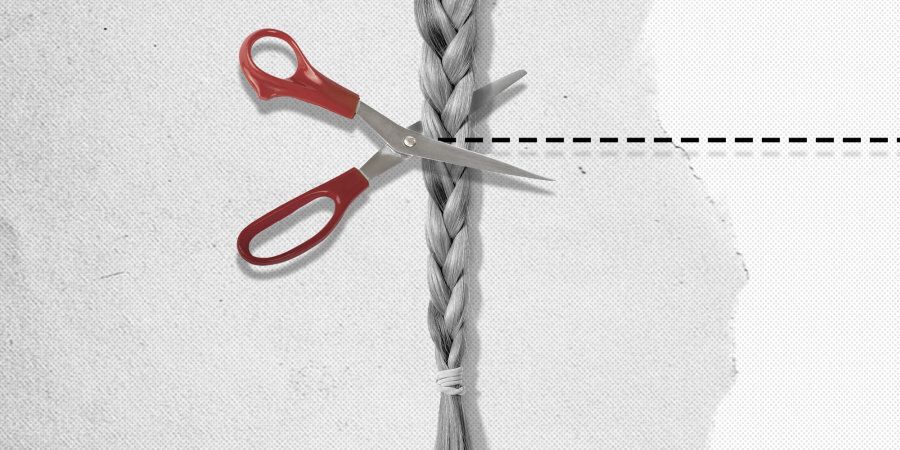
Bancroft is a rural municipality in eastern Ontario tucked in the northern tip of Hastings County. From downtown, it's a 2.5-hour drive east to Ottawa; 30 minutes to the northwest gets you to the bottom edge of Algonquin Provincial Park.
In 2016, town council approved an average increase of 53 per cent to the water and sewer rates. About 900 addresses within town limits — homes that are required to be connected to the municipal water system — were hit by the rate surge.
The increase was an unpopular move.
In Bancroft, incomes average $33,460, which is about 30 per cent lower than the provincial average of $47,915.
This is the kind of evidence they need to see.Carissa Card, Bancroft resident
Outraged residents shared pictures of their bills on Facebook. One photo showed a $523.72 water and sewer bill for a single-family unit for three months. Another invoice highlighted $719.20 for a two-month billing cycle. "There are still some people who don't think the water/sewer rate increase is a big deal," reads the caption. "This is the kind of evidence they need to see."
The town will cut off water after a few months of unpaid bills. If accounts go into arrears, it will tack the charges onto back taxes. After two years of lapsed payments, a recently amended bylaw allows the town to seize the property.
"It's been tight," said Carissa Card, a mother of three boys aged 6, 5, and 2. Ready-to-eat Jell-O and pudding packs were their favourite snacks — and the first items dropped off the grocery list.
The stay-at-home mom said her husband earns $18 per hour working full time at a rust removal company. His salary covers the bulk of their monthly expenses, including $1,500 rent and approximately $250 for the hydro bill.
Card receives $1,600 monthly from the Canada Child Benefit that's supposed to help with the costs of raising children. But she said roughly $250 of that goes to paying for water.
She shares a copy of her water bill dated Dec. 27, 2018. It's past due with $620 owing.
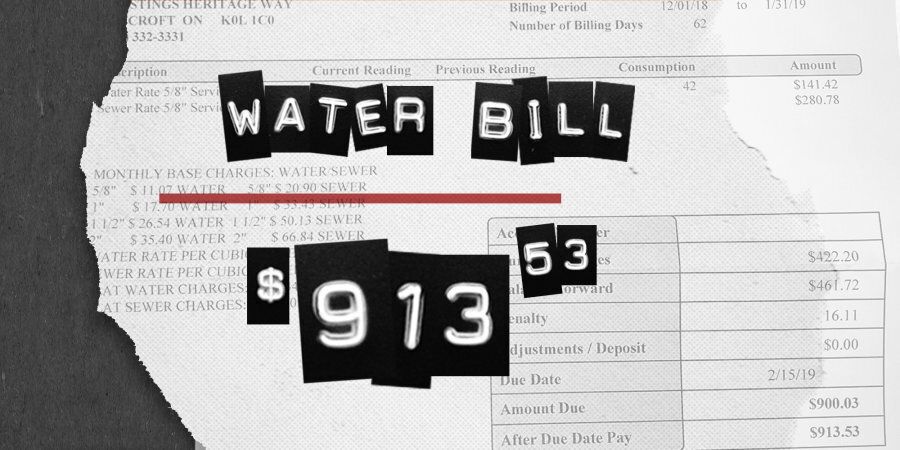
Others also struggle to fill their fridges, pantries, and cupboards. The food bank knows this. Usage has gone up 300 per cent since the water and sewer rates spiked at the beginning of 2017.
"Once you get behind it can be very difficult to catch up," said Wilma Brethour, a community activist who sits on the town's finance committee as a citizen member along with three councillors.
"It's the working poor that are really getting hit here."
Mayor Paul Jenkins was in that heated meeting last winter — and in that locked kitchen with councillors. He said they fled the protesters for "safety" reasons. At that time, he had been in the job for just over a month, coming into the role after his predecessor resigned.
The bill hikes, he said, have affected him too.
Before the rates jumped, Jenkins said his monthly water and sewer bill totalled around $120 for his two-person household. Now he and his wife pay around $190 for the same bill, an increase of 58 per cent.
"We're still not happy about it. But also we're working hard and doing everything we can to, you know, to come up with some sort of solution," the mayor said in an interview. "But we are limited in terms of what we can do."
* * *
Tourism drives the town's economy, so it's no surprise the municipality's biggest industry is retail, which is responsible for 255 jobs, followed by construction, with 200 jobs, according to Statistics Canada.
The town entices Bancroft's summer visitors to stay with an endearing slogan: "You belong here."
The population skews older. The average age here is 49, according to 2016 census data.
People who live in Bancroft say they love how peaceful it is.
Nearly 3,900 people call the town home. But that changes in the summertime when the quiet countryside swells with at least 40,000 cottagers. They travel through the town's three traffic lights to get groceries at the No Frills, buying bags of chips, burgers and maybe some corn if it's in season.
Some locals believe the population is actually smaller. They say the current count includes people who moved away last year — folks who found new homes in municipalities with cheaper water and sewer rates.

Identifying the cause for why people are leaving isn't hard. Under this sleepy community, just follow the water and sewer pipes back to the Bancroft's wastewater treatment plant. Constructed in 1974, and expanded in 2011, it was a costly and badly planned project that residents are now on the hook for.
In 2003, one of the last pieces of legislation passed by Ontario's Progressive Conservative government under Ernie Eves was the Nutrient Management Act. One of its provisions sought to ban the spreading of untreated septage — basically to keep human and animal waste from being pumped from septic tanks and sprayed onto farmland.
The law was intended to prevent another Walkerton, where six people died after the Ontario town's water supply was contaminated with E. coli. Almost half of Walkerton's residents got sick during the outbreak. It was Canada's worst public health disaster involving a contaminated water supply.
In Walkerton's aftermath, governments across Canada pursued new laws to prevent the spreading of septage near municipal wells to avoid E. coli contamination.
Watch: Remembering Walkerton's E. coli outbreak
To make it worthwhile for municipalities to stop dumping untreated waste onto agricultural lands, the Ontario and federal governments incentivized municipal officials. Existing wastewater plants became eligible for increased funding if they included new plants to treat septage.
Bancroft had a water treatment plant — and, recognizing a revenue opportunity, they pitched nearby communities and the province that it could expand its existing facility to service the entire North Hastings region (population: 12,000).
Documents show neighbouring towns, including Hastings Highlands and the Village of Limerick, signed declarations that part of their tax revenue would support the operational costs of Bancroft's expanded plant. The more users on the system, the lower the costs for everyone.
In 2005, the Canada-Ontario Municipal Rural Infrastructure Fund awarded Bancroft $6.4 million for the expansion project. Designers and engineers were hired to draft plans to increase the plant's wastewater treatment capacity to handle 10,000 septic tanks.
By then, the Ontario Liberals led by Premier Dalton McGuinty were two years into their mandate. Unexpectedly, the part of the Nutrient Management Act that mandated septage treatment was scrapped. It created a domino effect. Neighbouring municipalities saw no more reason to send their septage away for treatment. But costly upgrades were still needed for Bancroft's plant to meet new provincial guidelines.
The municipalities that partnered with Bancroft on principle bailed. Bancroft town council was left to figure out how it could pay for a turbo-sized facility it no longer needed, but wanted to keep as a possible revenue stream.
Despite the province changing septage rules forcing the town to redesign the facility, financial responsibility was — and remains — with the municipality.
* * *
Danny Palmer and his 13-year-old son use egg timers when they shower. Seven minutes each. It's one of several methods the widower has come up with to save cash since his water and sewer bill tripled two years ago. Under current rates, his annual bill is over $3,000.
"I only wash laundry on Saturday and I do most of the washing in the scrub tub," he said over the phone from his home in Bancroft. "And I use the washing machine only to rinse them out because I don't want water going into the sewer. And I take the water and I throw it outside in the yard so that it doesn't go into the sewer system and cost me money."
The former miner and labourer homeschools his teenage son, who has special needs. Palmer pays for educational supplies himself. This year's curriculum cost $600.
Covering basic needs was easier when his wife was alive, he said. She received $1,200 in monthly disability payments. The family got by with Palmer working three part-time jobs: stocking shelves at No Frills and at Canadian Tire, and taking night shifts at a gas station. He made around $2,200 monthly then, which he considers very good income for Bancroft.
"Not excellent, but you know comfortable."
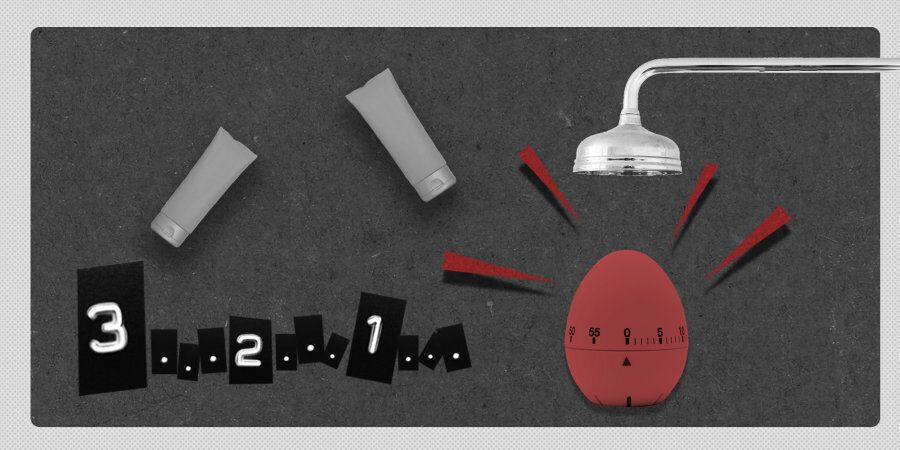
Palmer, 52, also receives disability payments now. For the past seven years, he's been getting treatment for cancer. The father of seven doesn't work much anymore as his body goes through rounds of chemotherapy and radiation.
Money has been stretched since his wife's sudden death in 2017. Palmer tells a joke, but there's sadness in his voice. He says he should have been the one to go.
The long-term math isn't promising. His monthly $1,300 disability cheque can't cover everything including the mortgage payment, taxes, food, "astronomical" hydro bills, or medicines not fully covered by the Ontario Health Insurance Plan or the Ontario Disability Support Program.
High water and wastewater bills have also hit the town's elderly, who make up nearly a third of the population, particularly hard.
"They have to choose whether they're going to buy their medications to keep them alive, or food to put on their table, or pay for electricity and water," Palmer said.
Something has to give for those on fixed incomes, and Palmer decided a while back that it would be the water and sewer bill. He hasn't paid it in about a year and a half and estimates he's about $5,000 in arrears.
He's upset town council isn't showing much empathy. He searches to understand where fairness comes in.
"They know that 80 per cent of the population is elderly and low-income. And because we're the ones inside the town, the ones that are on the rolls for taxes and water, we're the ones being penalized for it," he said.
They have to choose whether they're going to buy their medications to keep them alive, or food to put on their table, or pay for electricity and waterDanny Palmer, Bancroft, Ont. resident
Come May, it will be two years that Palmer's bills are in arrears. He's rushing to repair the family home so he can hopefully sell it before the town takes it. He figures he could walk away with $80,000 after the sale and move with his son to Thunder Bay, where he's scouted a property that boasts $380 in annual taxes.
His current home used to be his grandparents' old farmhouse. Palmer explains he's the only sentimental soul in the family who wants to hold onto it.
His mother used to live nearby, but she moved when her church left town last year. Both she and The Church of Jesus Christ of Latter-day Saints decided the bills had become too high and unsustainable to justify staying.
Palmer's mother now lives 17 kilometres west in Cardiff, Ont., where her annual water and sewer bill is $1,100. Palmer is billed three times that in Bancroft.
"I was raised here," he said, adding he would love to stay. But there's no way that he can pay off the $5,000 debt and still make ends meet. "The water bill and sewer is the straw that broke my back."
* * *
When neighbouring municipalities in North Hastings pulled out of the water treatment plant extension project, officials and engineers were rushed in to redesign it, decreasing its capacity, from 10,000 tanks to 2,000. The town had to pay nearly $700,000 for the new design.
The total budget ballooned to $11.5 million. Minus government funding, the town was responsible for paying $5 million — 10 per cent more than originally projected.
It's against the law for municipalities in Ontario to carry deficits for operational costs. The Town of Bancroft was forced to take out two long-term bank loans.
The plant was designed to handle a bigger capacity to accommodate population growth. The logic was simple: for the plant to actually make money, there needed to be more users paying to use it. More people needed to move to Bancroft.
But that isn't happening at all. Recent census data suggests growth is stagnant: the town's population in 2011 was 3,880 and went up by one in 2016.
* * *
There are 533 municipal wastewater systems across Ontario. They serve large metropolitan areas as well as rural towns; they range in size, condition, and operational costs. Wastewater produced by Toronto's 2.7 million residents is treated by four plants. Others service smaller populations, such as 313 people in the northern community of Latchford.
With the province's towns shrinking, and aging water-related infrastructure needing repair or replacement, small municipalities are feeling the financial pinch of maintenance costs.
Bancroft makes no revenue from its expanded wastewater plant. It's been a drain on municipal finances since 2011. The town was paying the Ontario Clear Water Agency, a third-party operator that managed the plant until 2017, approximately $500,000 more than what it collected from sewer bills, according to Bancroft This Week. Veolia Water Canada, Inc. currently operates the plant.
And there are operational issues. More money down the literal drain. Bancroft This Week reported the town has a seven-figure debt exacerbated by problems related to the treatment plant. Users have reportedly been overcharged because of rainwater and run-off seeping into sewer lines. Around 40 per cent of the treated water is lost before it reaches the town's taps through leaching. But there's no money to replace pipes.
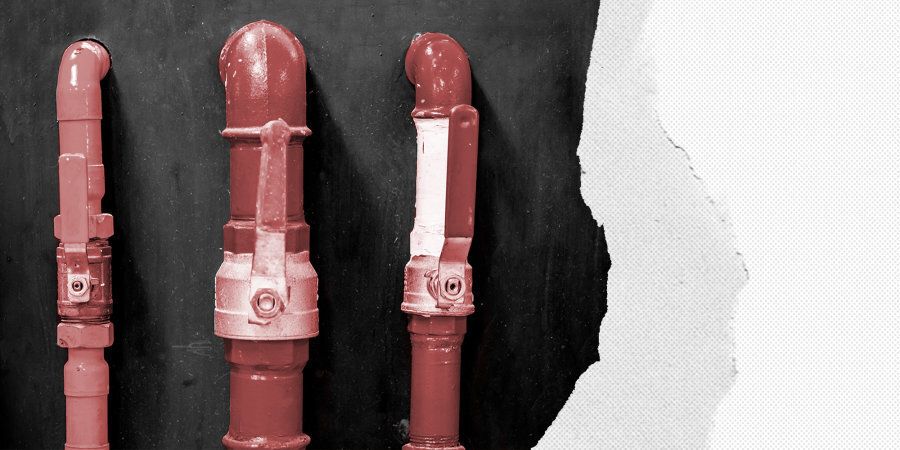
The government raised flags years ago about the mass delay in critical maintenance for the province's water systems. In 2005, Ontario published its Watertight report noting that $11 billion in necessary repairs posed a "serious and growing problem" for municipalities. It said $30 billion to $40 billion would be needed over the next 15 years to update water and wastewater infrastructure.
To offset worst-case scenarios, the report authors suggested municipalities "keep systems in good condition and conserve water," adding "governments in Ontario must also look for ways to reduce costs and moderate rates."
Seven per cent of the town's tax revenue is used to cover the plant's operational expenses.
"We subsidize it when we're really not supposed to," Mayor Jenkins says. "We could definitely use that money for other infrastructure projects, for roads and bridges and things of that nature .... it is having an impact, there's no question."
Rates shot up in 2017, despite the fact plant expansion wrapped in 2011. Some residents say town council took too long to mitigate the issue; others think it isn't aggressive enough in demanding provincial assistance.
Time is running out, explained town resident Jo-Anne Reynolds.
"In 2015, our wastewater rates were $2.61. In 2018 they jumped to $5.69. It's unreasonable," Reynolds said. The activist works with North Hastings Community Trust, an advocacy agency focused on poverty and social justice issues.
"That is not a reasonable inflation rate. Five per cent is one thing. A 100 per cent [increase] — with another increase coming in 2019, people are going to move. Businesses are going to shut down."
Hairdresser Tammy Lynn Vardy's business uses a lot of water and the increases have added significantly to her overhead. Her water bill for January-February 2016 was $313. That jumped to $952 for the exact same billing cycle in 2018.
A report written last year by the town's former chief administrative officer Hazel Lambe asked the Ontario government to pay for the financial mess it created.
That is not a reasonable inflation rate. Five per cent is one thing. A 100 per cent [increase] — with another increase coming in 2019, people are going to move. Businesses are going to shut down.Jo-Anne Reynolds
"How the Wastewater Treatment Plant project transpired was at no fault whatsoever of the Town of Bancroft," it reads. "Respectfully, the Town of Bancroft requests a repayment in the amount of the $1,244,340 to compensate the Town for unfavourable and costly decisions made for the Town by the Province."
Queen's Park has yet to acknowledge its role in Bancroft's financial troubles.
"The high cost that we are forced to operate under are not sustainable, especially rural municipalities," Jenkins said. "We sort of feel rural municipalities are being treated somewhat as second-rate citizens."
The federal-provincial fund that awarded Bancroft $6.4 million to upgrade its plant no longer exists. It was a five-year initiative that ended in 2009.
Ministry of Infrastructure spokeswoman Sofia Sousa-Dias said in 2008, when the program was active, Bancroft applied for $1.2 million to help pay design costs for a smaller plant. Rules prevented the request from going through, she said.
"The province and federal government were not able to accommodate these requests due to the constraints of the overarching federal-provincial agreement, which did not consider expenses associated with cost overruns eligible."
Because plant upgrades ended in 2011, the town isn't eligible for current provincial infrastructure funding to help pay for completed water and wastewater projects.
"The town could submit an application for a new project," Sousa-Dias said.
Bancroft officials say their plan now is to focus on courting more residential and commercial developers — more users on the system. But with the current water and sewer rates unchanged, it's been a hard sell.
Walmart had considered opening a store in Bancroft, but backed out after deciding it wasn't an economically feasible choice.
Bancroft has among the highest rates for water and wastewater in the province.
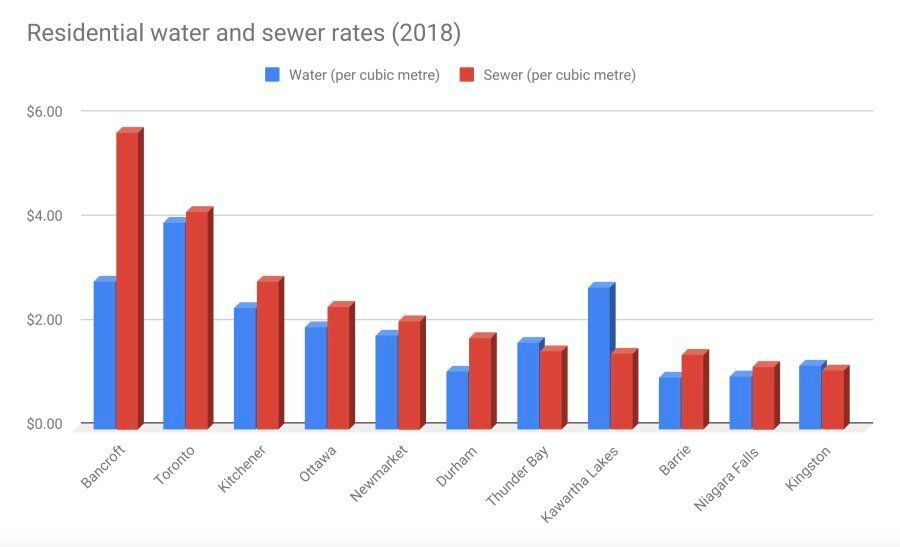
Bancroft's water and sewer rate hike has illuminated another issue: a lack of affordable housing.
Before Palmer settled on the idea to move to Thunder Bay, he searched his hometown for alternative housing. But the options were slim, let alone in his price range. And if he found something, chances were the expensive water and sewer bill would follow him. "Only people coming up from the cities can afford to live here," he said.
There was no point getting into one of Bancroft's 60 low-income housing units, which are subject to the same high rates.
His son isn't happy about the idea of uprooting, but he understands his dad is choosing to make the hard decision to leave. Palmer said he was initially very angry and bitter about the situation. He's now focusing on selling the house before the town can seize it.
Nostalgia sets in. When he was 12, he used to help his construction-worker grandfather build cottages in the area. He jokes about all the years he spent doing the groceries at night to avoid the throng of tourists out in the daytime.
His grandparents' home has been a peaceful place to live, he said. But they're "memories I can take with me."
The widower shares more about the northern property he's planning to buy if he can sell this one. He calculates land and house construction would cost $94,000. It's a non-organized township so no building permits are required. They can build whatever they please.
"It's your property, nobody's ever going to come in and move you out of there," he said.
He drops details of the future he's been envisaging. The house will be off-grid and self-sustaining, set on 160 acres, their 160 acres, with timber and mineral rights — and access to their own freshwater supply.
There's no talk of water and sewer bills.